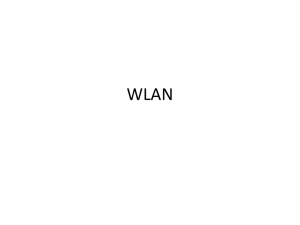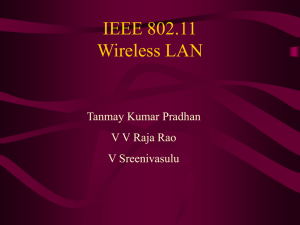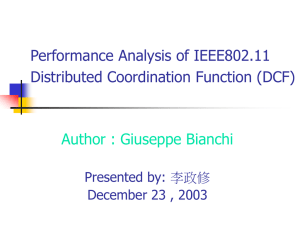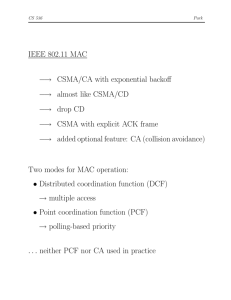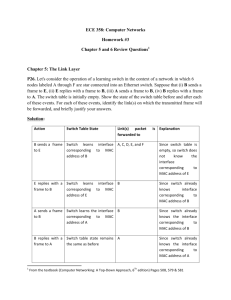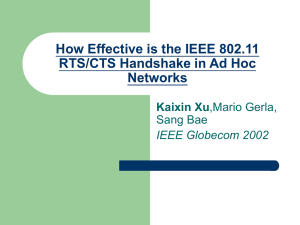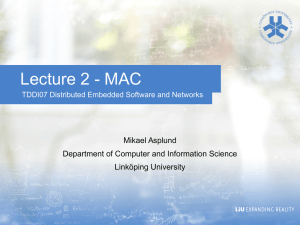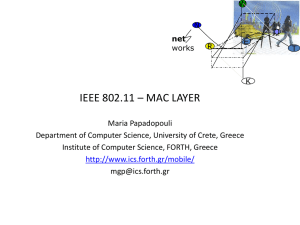Mobile Ad-hoc Networks: Issues and Challenges
advertisement
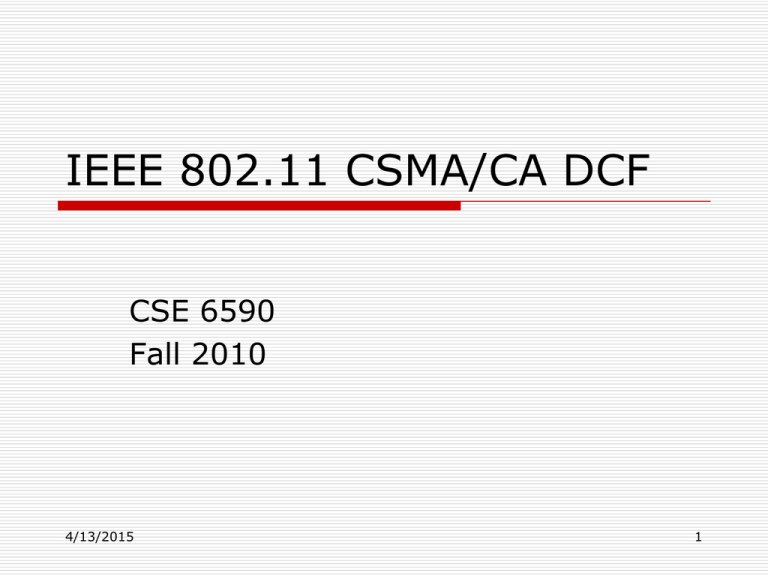
IEEE 802.11 CSMA/CA DCF CSE 6590 Fall 2010 4/13/2015 1 MAC Requirements To avoid interference among simultaneous transmissions But enable as many non-interfering transmission as possible Maintain fairness among transmissions No centralized coordinators: fully distributed operations No clock synchronization: asynchronous operations 4/13/2015 2 Carrier Sensing Problems Hidden terminal problem Exposed terminal problem Sensing range Transmission range Contention matters only at the receiver’s end 4/13/2015 3 Hidden Terminal Problem B A X No carrier OK to transmit 4/13/2015 4 Exposed Terminal Problem B A Y X Presence of carrier holds off transmission 4/13/2015 5 Existing Work MACA [Karn 1990] Proposes to solve the hidden terminal problem by RTS/CTS dialog MACAW [Bharghanvan 1994] Increasing reliability by RTS/CTS/DATA/ACK dialog IEEE 802.11 Distributed Coordination Function (DCF) Also use RTS/CTS/DATA/ACK dialog 4/13/2015 6 RTS/CTS dialog (1) Defer RTS Any node hearing this RTS will defer medium access 4/13/2015 7 RTS/CTS dialog (2) Defer Defer RTS CTS Any node hearing this CTS will defer medium access 4/13/2015 8 RTS/CTS/DATA/ACK dialog Defer Defer Data ACK 4/13/2015 9 IEEE 802.11 DCF Uses RTS/CTS exchange to avoid hidden terminal problem Any node overhearing a CTS cannot transmit for the duration of the transfer. Any node overhearing an RTS cannot transmit for the duration of the transfer (to avoid collision with ACK) Uses ACK to achieve reliability CSMA/CA Contention-based random access Collision detection not possible while transmitting 4/13/2015 10 IEEE 802.11 DCF (cont.) Carrier sense in 802.11 Physical carrier sense Virtual carrier sense using Network Allocation Vector (NAV) RTS/CTS specify duration of subsequent DATA/ACK NAV is updated based on overheard RTS/CTS Collision avoidance Nodes stay silent when carrier sensed busy (physical/virtual) Backoff intervals are used to reduce collision probability 4/13/2015 11 Backoff Interval When channel is busy, choose a backoff interval in the range [0, cw]. Count down the backoff interval when medium becomes idle. Count down is suspended if medium becomes busy again. When backoff interval reaches 0, transmit RTS. Binary exponential backoff in 802.11 DCF: When a node fails to receive CTS, cw is doubled up (up to an upper bound). When a data transfer completes successfully, cw is reset to cwmin. 4/13/2015 12 IEEE 802.11 CSMA/CA – Example DIFS: DCF inter-frame space 4/13/2015 SISF: short inter-frame space 13 Disadvantages of IEEE 802.11 DCF High power consumption Hidden terminal problem not totally solved (e.g., collision of RTS) Exposed terminal problem not solved Fairness problem among different transmitting nodes Only providing best-effort service 4/13/2015 14 Detailed 802.11 DCF 4/13/2015 15 Media Access Control 16 Distributed Coordination Function DCF sublayer uses CSMA if station has frame to send it listens to medium if medium idle, station may transmit else waits until current transmission complete No collision detection since on wireless network DCF includes delays that act as a priority scheme 17 Basic CSMA/CA operations Fig. 6.69 (Leon-Garcia) 18 IEEE 802.11 Medium Access Control Logic 19 Transmission without RTS/CTS Fig. 6.71 (Leon-Garcia) 20 Transmission with RTS/CTS Fig. 6.72 (Leon-Garcia) 21 Priority IFS Values SIFS (short IFS) for all immediate response actions (see later) PIFS (point coordination function IFS) used by the centralized controller in PCF scheme when issuing polls DIFS (distributed coordination function IFS) used as minimum delay for asynchronous frames contending for access 22 SIFS Use SIFS gives highest priority over stations waiting PIFS or DIFS time SIFS used in following circumstances: Acknowledgment (ACK) station responds with ACK after waiting SIFS gap for efficient collision detect & multi-frame transmission Clear to Send (CTS) station ensures data frame gets through by issuing RTS and waits for CTS response from destination Poll response see Point coordination Function (PCF) discussion next 23 PIFS and DIFS Use PIFS used by centralized controller for issuing polls has precedence over normal contention traffic but not SIFS DIFS used for all ordinary asynchronous traffic 24 IEEE 802.11 MAC Timing Basic Access Method 25 IEEE 802.11 MAC Frame Format 26 MAC for Multicast 4/13/2015 27 MAC for Multicast: a Challenging Issue Multicast: efficient info delivery from a source to a set of destinations simultaneously Uses 802.11 CSMA/CA Cannot use RTS/CTS exchange Currently there are no effective MAC protocols for multicast 4/13/2015 28 Reading Data and Computer Communications by William Stallings, Chapter 17 Communication Networks by Alberto Leon-Garcia, Chapter 6 4/13/2015 29

